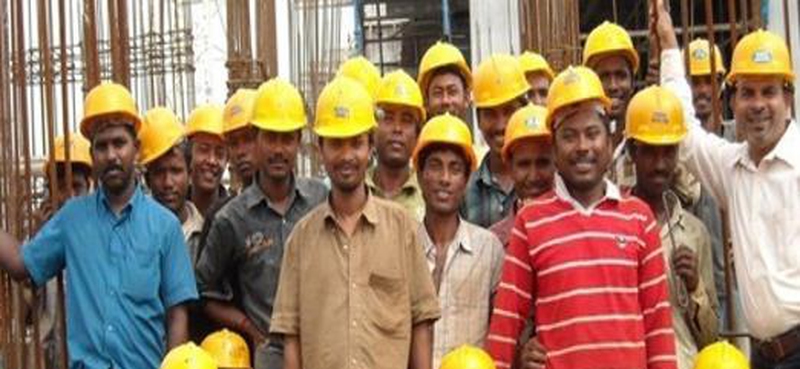The unskilled labor definition is one who performs tasks of a repetitive nature, which requires no prior experience or independent judgment. As much as the tasks are expected to physically exhausting, familiarity with the work environment is the only expectation from unskilled labor. Typical examples of unskilled workforce in USA are called as Watchman, Sweeper, Durban, Loader, Peon, Helper etc. A skilled labor is identified by the responsibility and judgment by which he performs his task. A thorough knowledge of the function and the industry marks level of the skilled employee and could classify him to be a highly-skilled employee. A semi-skilled employee definition falls between that on a skilled and unskilled labor.
7 Career Tips For Unskilled Labors
Government Clerks
Developing world has the second largest workforce with about 487 million people according to the last census on 2012. The organized sector such as government offices, public sector units, and the private sector organization employ about 17.3 million workers, this rendering 94 percent of the workforce in the unorganized sector. It is presumed that 30% of this workforce is unskilled, but there are no verifiable resources provided by the Government to authenticate this large number.
These facts definitely pose the following major issues:
Unemployment due to Skill gap – 67% of employers find that they find it difficult to find labor that have the required skills. 80% of the workforce does not possess marketable skills.
Migration of workers – Migrant workers are in two distinct groups – about 4 million in the he Middle-east alone, and an additional 4 .3 million domestic migrant workers.
Financial traps – As much as bonded unskilled labor has been abolished in developing world, the nature of employment forces the unorganized workforce to avail loans from private entities. The rate of return based on the availability of funds is so high, that workforce is under constant employment opportunities alone
Child unskilled labor – Many constitutions around the world prohibits child labor. However study does reveal that 4.98 million children in the age group of 5-14 are still employed in the unorganized sectors.
Mansion Builders
The above startling statistics and issues combined with the skill gaps as depicted provides a thought provoking impetus to identity ways and means of changing the skill levels.
The unskilled labor workforce looks for ways and means to move up their skill index. Some tips for the unskilled workforce which will not only help them from a work perspective but also enable them to move up the social-economic ladder. What is diversity between skilled and unskilled labor? The skilled labor
Education Helpers
Focus on availing primary education is prime-most for the unskilled labor workforce. There are lots of avenues set up by the government and private sectors to avail education upto high school in the regions of residence.
Vocational Training
An ambitious project that has been kick started as early as 2009 is the formation of “National Policy for Skill Development”. The aim of this policy is that by 2022, there will be a skilled workforce base of 12.8 million added every year. There are various centers setup by institutes created by Public-Private-Partnerships. There are numerous course offered by government run Industrial Training Institutes (ITI). Out of the 116 course offered, where nearly all of them studies till Class 10, only 20 of them have a pre-requisite of Class 8. Hence the policy and the various centers only reiterate the fact that primary education is of utmost importance to move up the skill level.
Thus, vocational training helps unskilled labor to develop some skills so that they could earn a living.
Guardians
A major step taken by the government is to help create zero balance saving accounts for the entire population. This is a major boost from the Banking and financial Institutions so that the masses can avail financial assistance from organized sectors.
Relocation from native villages is an impetus to many an unskilled labor. The lure of better employment and a livelihood is definitely a contributing factor. However due to the limited knowledge, not many people avail of the opportunities. The low numbers are a definite indication. Helping them make informed decisions to migrate will help the workforce and the employment opportunities available. Thus, there are being attempts to convert unskilled labor to skilled labor.
Unemployment Exchange
What is literature text saying about labor statistics? Enrollment in Employment Exchanges can ensure that the jobs with defined roles can be availed. This ensures a first step movement from the unskilled to the semi-skilled roles opening up further opportunities for the discerning. Create a drive to increase the organized sector base, such that more enterprises can be classified into this segment. This will open opportunities for the unskilled labor, just as the skilled workforce also get their due recognition of finding befitting opportunities.
Formation of recognized unions by the unskilled labor workforce will create an impact on the various industry segments in developing countries. As much as technology and automation offer productivity enhancement in many industries, the quantity of the existing skilled and unskilled labor can be retrained. The unions can influence the government to provide incentives for such initiatives. This is bound be a win-win situation for the various stakeholders in the given industry.
Self-Help Groups
Self-help groups and motivators as available for the skilled workforce and the organized sector should be created amongst the unskilled labor force too. Thanks to the caste-system which has been prevalent from time immemorial, there have been privilege for only for skilled and unskilled labor have always been looked down upon, especially in the rural areas. There needs to be a change in the acceptance of the unskilled workforce by the various sections of society in a broader sense. As much as the media does play a significant role in highlighting the challenges faces by the unskilled labor, there needs to be a greater momentum of positive reinforcement of their acceptability.
Conclusion
The suggestions here are merely based on the study of the employment landscape in our developing world, where we are poised with challenges despite having the second largest work force. Reducing the unskilled labor is one positive step to create the workforce that we aspire to be.









View All Comments /Add Comment